To elevate your tea blend's flavor profile, try adding herbs like chamomile for soothing notes and peppermint for a revitalizing kick. Lavender brings a floral aroma while ginger adds warmth and zing. If you want sweetness, consider stevia or licorice root. Spicy herbs like cinnamon and cardamom introduce a delightful twist, while earthy options like rooibos and sage warm the palate. For a bright note, add lemon balm or lemongrass. Mixing these herbs can create unique combinations that tantalize your taste buds. Stick around to discover even more ways to enhance your tea experience!
Popular Herbs for Tea Blends
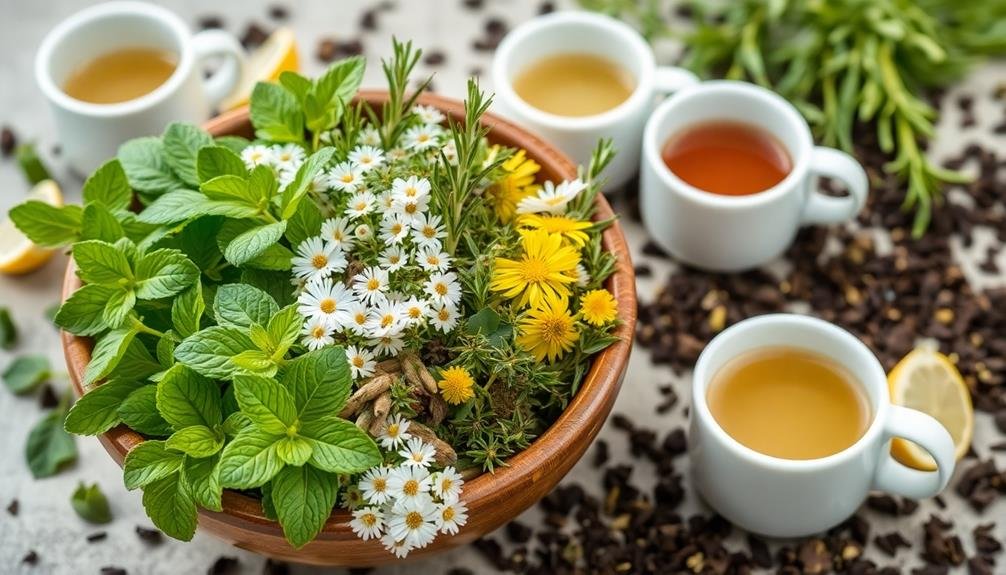
When it comes to creating the perfect tea blend, choosing the right herbs can make all the difference. You'll want to explore a variety of popular herbs that can elevate your tea experience. Some favorites include chamomile, known for its calming properties, and peppermint, which adds a revitalizing zing.
If you're looking for something floral, lavender is a delightful choice that complements many blends. For a touch of spice, consider ginger or cinnamon. Ginger provides warmth and a hint of heat, while cinnamon adds sweetness and depth.
If you prefer something more earthy, rooibos is an excellent caffeine-free option that delivers a rich, smooth flavor. Don't overlook lemongrass, either. It brings a bright, citrusy note to your blends, perfect for a summer tea.
You might also enjoy hibiscus, with its vibrant color and tartness, which can add an exhilarating twist. Experimenting with these herbs will help you discover unique combinations that suit your palate.
Balancing Flavor Profiles
To create a harmonious tea blend, it's essential to balance the various flavor profiles of your chosen herbs. Start by identifying the primary flavors—whether they're earthy, floral, spicy, or citrusy. Each herb has its unique taste, and when combined, they can either complement or clash with one another.
Consider the intensity of each herb. For instance, a robust herb like ginger can easily overpower milder flavors such as chamomile or mint. To avoid this, you might use ginger sparingly, allowing the subtler herbs to shine through. Experimenting with proportions is key; you can adjust the amounts until you find the right harmony.
Don't forget about aroma, too. A well-balanced blend not only tastes good but also smells inviting. If you find that your blend feels one-dimensional, consider adding an herb with a contrasting flavor profile to create depth. For example, if your blend is mainly sweet, adding a hint of something herbal or slightly bitter can elevate the overall experience.
As you practice balancing flavors, you'll develop a keener sense of what works well together, paving the way for delightful tea blends that tantalize your taste buds.
Herbs for Sweetness
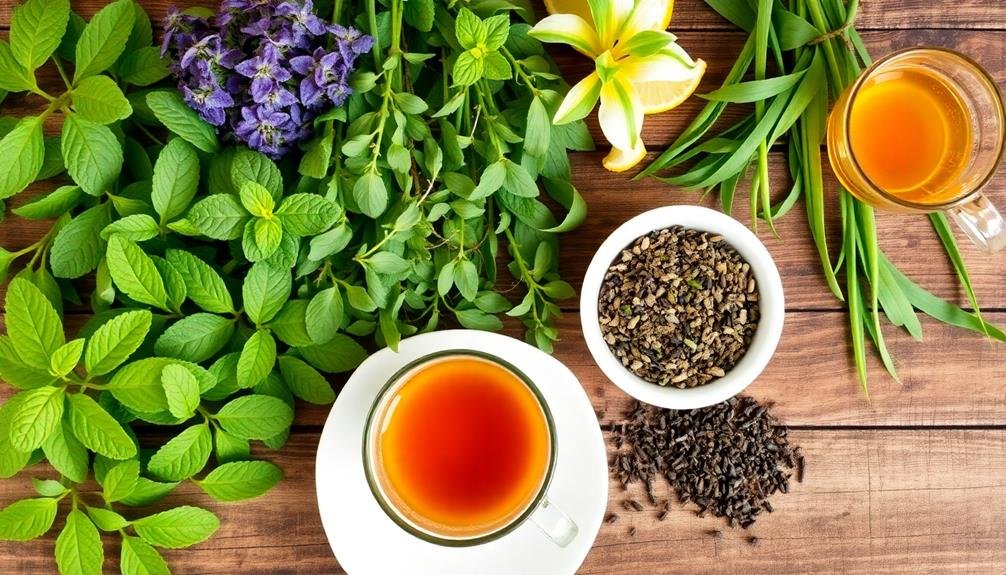
Adding herbs for sweetness can transform your tea blend into a delightful experience without relying solely on sugar. By incorporating the right herbs, you can enhance the natural flavors of your tea while adding a touch of sweetness. Here are a few herbs that you might consider:
| Herb | Flavor Profile |
|---|---|
| Stevia | Intense sweetness, herbal |
| Licorice Root | Rich, sweet, slightly earthy |
| Fennel Seeds | Sweet, slightly anise-like |
| Mint | Invigorating, mildly sweet |
Stevia is a popular choice for those looking for a natural sweetener. Its intense sweetness can elevate your blend with just a small amount. Licorice root adds a rich sweetness and a unique depth, perfect for balancing more robust flavors. Fennel seeds offer a sweet, anise-like taste that complements fruity or floral teas beautifully. Finally, mint brings a invigorating sweetness that can brighten your blend, especially in iced teas. Experimenting with these herbs can help you create a deliciously sweet tea blend without the need for added sugars. Enjoy the natural goodness!
Enhancing Aroma With Herbs
Aromatic herbs can elevate your tea blends, creating an enticing sensory experience that complements the flavors and sweetness you've already crafted. When you add these herbs, they not only enhance the taste but also release delightful fragrances that can transform your tea-drinking ritual.
Here are some aromatic herbs you might consider incorporating into your blends:
- Lavender: Offers a floral aroma that soothes and relaxes.
- Mint: Provides an invigorating scent that invigorates the senses.
- Basil: Adds a sweet, slightly spicy fragrance that enlivens your blend.
- Rosemary: Brings a woodsy aroma that deepens the flavor profile.
- Lemon balm: Infuses a citrusy scent that uplifts and brightens.
Experimenting with these herbs allows you to discover unique combinations that resonate with your palate.
Remember, a little goes a long way; start with small amounts and adjust according to your preference.
By focusing on the aroma, you can create a multi-layered tea experience that keeps you coming back for more.
Spicy Herbs in Tea
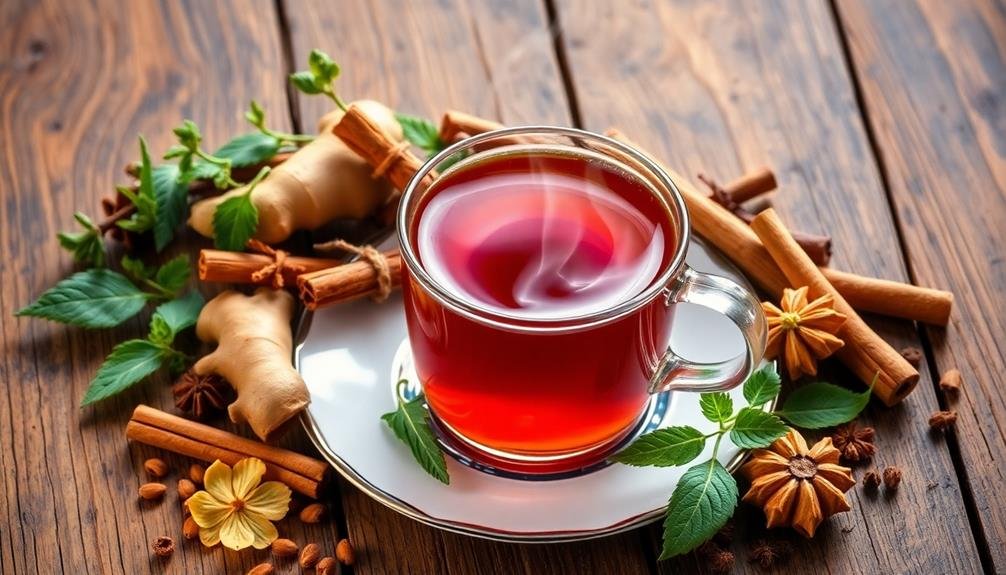
When you think of spicy herbs in tea, options like ginger and cinnamon probably come to mind.
These herbs not only add a delightful kick to your brew but also offer various health benefits worth exploring.
Let's take a closer look at some popular spicy herbs and how they can enhance your tea experience.
Popular Spicy Herbs
Many tea enthusiasts love incorporating spicy herbs into their blends for an extra kick of flavor and warmth.
These herbs not only enhance your tea experience but also create unique combinations that tantalize your taste buds. Here are some popular spicy herbs you might consider adding to your tea blends:
- Ginger: Known for its zesty bite, it adds a warming sensation and pairs well with many teas.
- Cinnamon: This aromatic spice offers a sweet and slightly spicy flavor that complements herbal and black teas beautifully.
- Cardamom: With its distinct, sweet-spicy profile, it adds depth and complexity to chai blends and other teas.
- Cloves: These tiny buds pack a punch with their bold flavor, making them perfect for spiced tea blends.
- Black Pepper: Adding a subtle heat, it can elevate your tea's flavor profile, especially in chai or herbal blends.
Experimenting with these spicy herbs can transform your tea-making experience.
Health Benefits Explored
Spicy herbs like ginger, cinnamon, and cardamom not only elevate the flavor of your tea but also come packed with health benefits.
Ginger's anti-inflammatory properties can help soothe an upset stomach and alleviate nausea. When you sip on ginger tea, you're not just enjoying a warm beverage; you're also giving your digestive system a gentle boost.
Cinnamon, on the other hand, is known for its ability to regulate blood sugar levels. Adding a dash of cinnamon to your tea can help improve insulin sensitivity, making it a great choice for those looking to maintain healthy glucose levels.
Plus, its antioxidant-rich profile supports overall heart health.
Cardamom, with its unique aroma, is another spicy herb worth considering. It's believed to aid in digestion and can even freshen your breath!
Cardamom also has anti-inflammatory properties, making it an excellent addition to your wellness routine.
Incorporating these spicy herbs into your tea blends not only enhances flavor but also delivers a variety of health benefits.
Mint Varieties for Freshness
When it comes to mint varieties, you've got plenty of options to choose from, each offering its own unique freshness.
Peppermint and spearmint are popular choices, but don't overlook lesser-known types like chocolate mint or pineapple mint for a twist.
Pair them with complementary flavors like lemon or ginger to elevate your tea blends even further.
Types of Mint Varieties
If you're looking to elevate your tea blends, exploring different mint varieties can make a significant difference in freshness and flavor. Each type of mint offers unique characteristics that can enhance your tea experience.
Here are some popular mint varieties you might consider:
- Peppermint: Known for its strong, cooling flavor, peppermint adds a revitalizing punch to any tea blend.
- Spearmint: With a sweeter and milder taste, spearmint is perfect for those who prefer a softer mint flavor.
- Chocolate Mint: This variety combines mint and a hint of chocolate, adding an intriguing twist to your tea.
- Apple Mint: Featuring a fruity undertone, apple mint can introduce a unique sweetness to your blends.
- Pineapple Mint: With its pineapple-scented leaves, this variety offers a tropical twist, perfect for summer teas.
Experimenting with these mint varieties can breathe new life into your tea blends. You can mix and match them to find the perfect combination that suits your palate.
The right mint can transform a simple cup of tea into a revitalizing experience, so don't hesitate to explore!
Flavor Pairing Suggestions
A variety of flavor pairings can enhance the crispness of your mint-infused tea blends. By mixing different ingredients, you can create a rejuvenating experience that excites your palate. Here are some fantastic combinations to reflect upon:
| Mint Variety | Flavor Pairing | Notes |
|---|---|---|
| Peppermint | Lemon | Brightens and balances flavor |
| Spearmint | Cucumber | Adds a cool, crisp element |
| Chocolate Mint | Dark Chocolate | Rich, indulgent contrast |
| Apple Mint | Green Apple | Sweet and tangy twist |
| Pineapple Mint | Fresh Pineapple | Tropical, invigorating vibe |
These pairings not only complement the mint's natural flavor but also introduce new dimensions to your tea. Whether you're brewing a hot cup or preparing a revitalizing iced tea, these suggestions can elevate your drink. Don't hesitate to experiment; you might discover a unique combination that becomes your new favorite. Remember, the key is to balance the mint's crispness with complementary flavors, ensuring each sip is delightful.
Floral Herbs and Their Benefits

Floral herbs bring a vibrant touch to tea blends, offering not just aesthetic appeal but also numerous health benefits. When you incorporate these herbs into your tea, you're not only enhancing flavor but also tapping into their unique properties.
Here are some floral herbs you might consider adding:
- Chamomile: Known for its calming effects, it can help reduce anxiety and improve sleep quality.
- Lavender: This aromatic herb is great for stress relief and can aid in digestion.
- Hibiscus: Rich in antioxidants, it may contribute to heart health and lower blood pressure.
- Elderflower: Often used for its immune-boosting properties, it can help fight off colds and flu.
- Rose Petals: They add a lovely fragrance and can promote skin health and emotional well-being.
Experimenting with these floral herbs can elevate your tea blends, making them not only delicious but also beneficial for your overall health.
Citrus Herbs for Brightness
When you're looking to brighten your tea, citrus herbs like lemon balm and lemongrass can elevate your blend.
Lemon balm not only adds a revitalizing taste but also offers calming benefits, while lemongrass brings a zesty flavor that awakens the senses.
Incorporating these herbs can transform your tea into a vibrant experience.
Lemon Balm Benefits
Known for its revitalizing scent and calming properties, lemon balm (Melissa officinalis) offers a delightful addition to tea blends that promote brightness and clarity. This herb not only enhances the flavor of your tea but also provides a range of benefits that can uplift your mood and support your well-being.
When you include lemon balm in your tea, you can enjoy:
- Mood Enhancement: Its calming effects may help reduce anxiety and elevate your spirits.
- Digestive Support: Lemon balm can soothe upset stomachs and aid digestion.
- Antioxidant Properties: Rich in antioxidants, it helps combat oxidative stress in your body.
- Sleep Aid: It's known to promote relaxation, making it a great choice for evening teas.
- Cognitive Boost: Some studies suggest it can improve memory and cognitive function.
Incorporating lemon balm into your tea blend not only brightens the flavor but also enriches your experience with its numerous health benefits.
Lemongrass Flavor Notes
Lemongrass (Cymbopogon citratus) brings an invigorating citrus flavor that perfectly complements tea blends, adding a vibrant brightness that can elevate your experience. Its fresh, zesty notes create a revitalizing aroma, making your tea feel more lively and uplifting.
When you incorporate lemongrass, you're not just enhancing the flavor; you're also introducing a delightful complexity that can balance richer or more robust herbs. You'll find that lemongrass pairs beautifully with other citrus herbs like lemon balm and mint.
Try blending it with green tea for a rejuvenating iced version, or add it to herbal blends for a fragrant twist. Experimenting with lemongrass can lead you to discover new flavor combinations that you mightn't have considered before.
When brewing, remember that a little goes a long way. Too much can overpower your blend, so start with a small amount and adjust to your taste.
Whether you're looking to energize your morning or unwind in the evening, lemongrass can add that perfect touch of brightness to your cup. So next time you brew, don't forget to include this zesty herb for an elevated tea experience.
Earthy Herbs to Ground Flavors
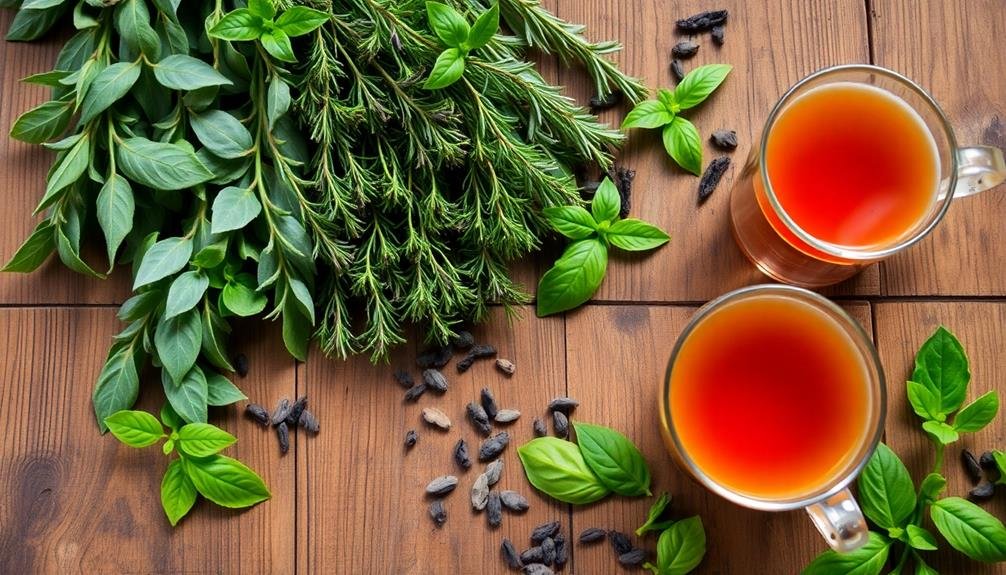
As you explore the world of herbal tea blends, earthy herbs can play an essential role in grounding flavors and creating a balanced cup.
These herbs bring depth and richness, enhancing the overall experience. Incorporating earthy herbs can help you achieve a comforting and robust flavor profile.
Here are some earthy herbs to contemplate for your blends:
- Rooibos: Naturally caffeine-free, rooibos has a warm, nutty flavor that pairs well with other herbs.
- Peppermint: While it has an invigorating quality, it also brings a subtle earthiness that grounds lighter flavors.
- Thyme: This herb adds a savory note, enhancing the complexity of your tea with its robust character.
- Sage: With its strong, earthy taste, sage can create a soothing blend that evokes a sense of calm.
- Nettle: Often overlooked, nettle contributes a grassy flavor that balances sweeter and spicier herbs beautifully.
Herbal Combinations to Try
When you're ready to experiment with herbal tea blends, consider how different combinations can elevate your sipping experience.
Start with a classic mix by pairing chamomile with mint. The soothing properties of chamomile balance the revitalizing notes of mint, creating a delightful, calming cup.
If you're looking for something bolder, try ginger and lemongrass. Ginger adds a spicy kick, while lemongrass brings a citrusy brightness, perfect for an invigorating afternoon pick-me-up.
For a floral touch, blend hibiscus with rose petals. This combination offers a vibrant, tart flavor from hibiscus, complemented by the delicate sweetness of rose, making it a stunning tea both in taste and appearance.
You might also enjoy a spiced chai blend by mixing cinnamon, cardamom, and cloves. This trio creates a warm, aromatic experience that's fantastic for chilly days.
Lastly, don't overlook the power of lavender with lemon balm. Lavender provides a calming floral note, while lemon balm adds a revitalizing citrus twist, ideal for relieving stress.
Experiment with these combinations, and find your perfect herbal tea blend that excites your palate and enhances your relaxation.
Frequently Asked Questions
How Do I Choose the Right Herbs for My Tea Blend?
Choosing the right herbs for your tea blend involves experimenting with flavors you enjoy. Start with a base herb, then add complementary herbs, balancing bitterness and sweetness. Don't hesitate to adjust until it feels just right!
Can I Use Dried Herbs Instead of Fresh Ones?
Yes, you can use dried herbs instead of fresh ones. Dried herbs often have a concentrated flavor, so you'll need less. Just adjust the quantity based on your taste preferences to achieve the desired flavor.
Are There Any Herbs to Avoid in Tea Blends?
When crafting your tea blends, you should avoid strong herbs like sage or rosemary, as they can overpower other flavors. Also, steer clear of any herb you're allergic to, ensuring a pleasant drinking experience.
How Can I Store Herbs for Tea to Maintain Freshness?
To store herbs for tea, keep them in airtight containers away from light and moisture. You'll want to label them with dates, and regularly check for freshness to guarantee you're enjoying the best flavors.
What Are the Health Benefits of Specific Tea Herbs?
When you explore specific tea herbs, you'll find many health benefits. For example, ginger aids digestion, chamomile promotes relaxation, and peppermint can soothe headaches. Incorporating these herbs into your tea enhances both flavor and wellness.
In Summary
Experimenting with herbs can truly elevate your tea blends' flavor profile. Whether you're seeking sweetness, spice, or a touch of floral elegance, there's a herb that's perfect for your blend. Don't hesitate to mix and match to find your ideal combination. Trust your taste buds, and enjoy the journey of creating unique and delightful tea experiences. So go ahead, brew a cup, and savor the vibrant flavors that herbs can bring to your tea!

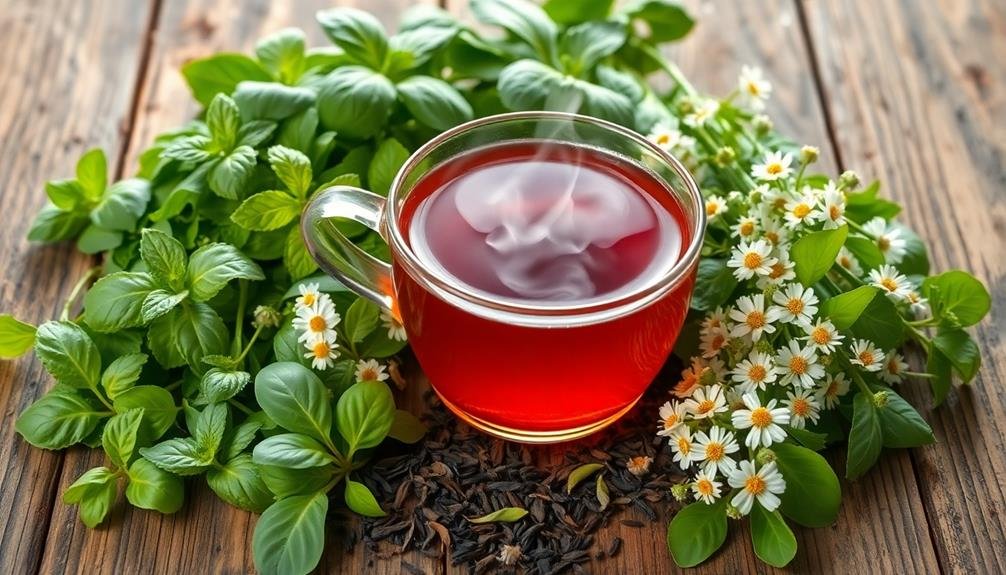
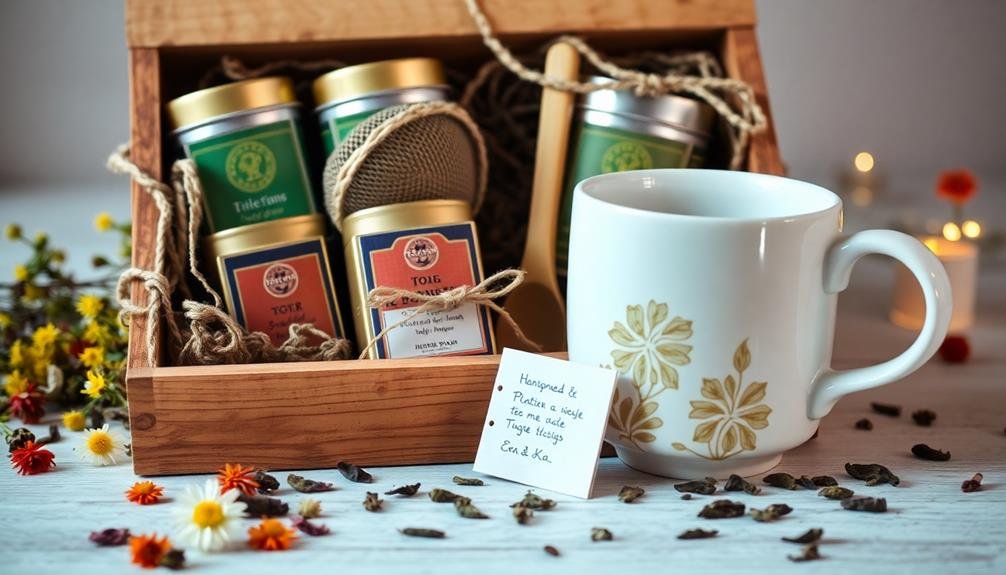
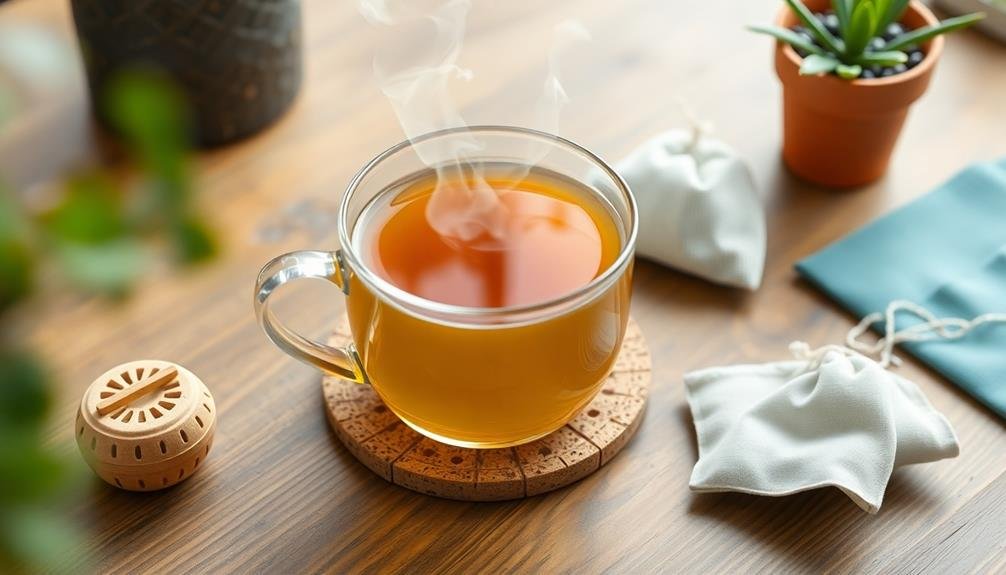
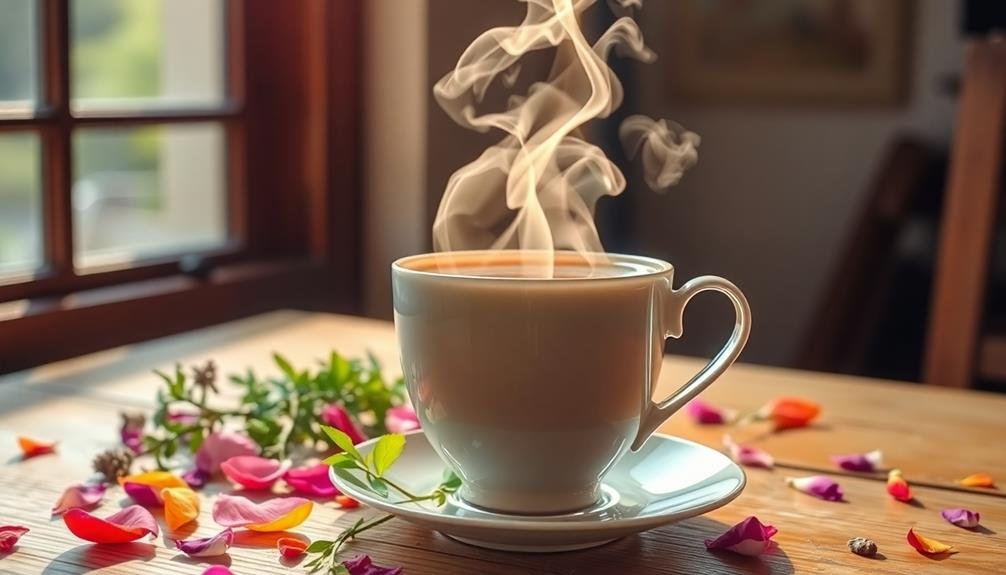
Leave a Reply